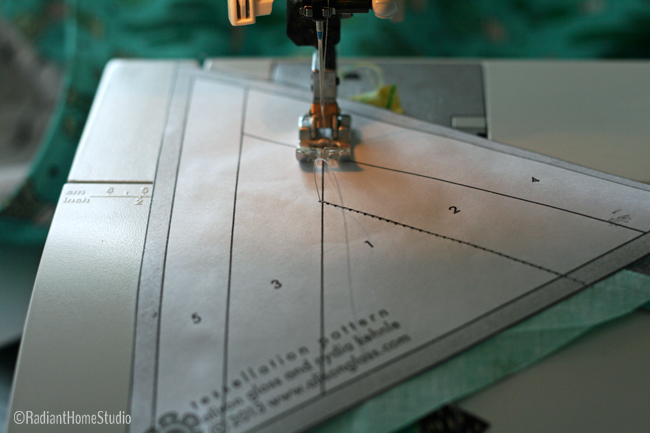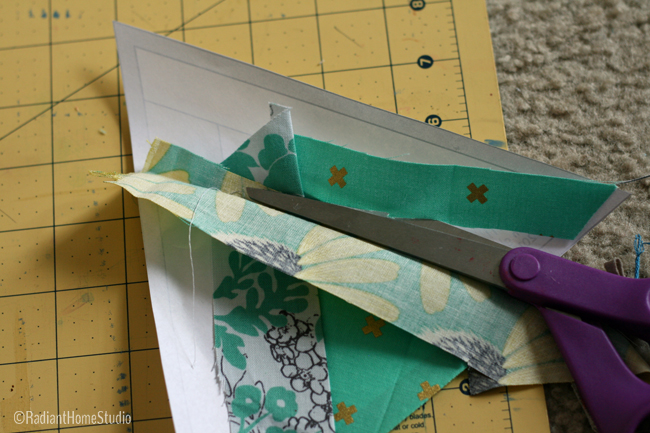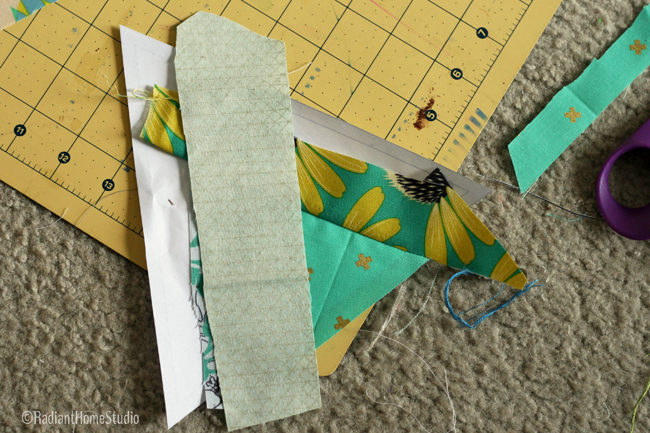As much as I sew, I haven’t done much quilting over the years. I made a simple baby quilt for my daughter and pieced some duvet covers for the kids’ beds. They were simple block patterns, but I did not enjoy the picky cutting and it drove me crazy that I couldn’t get the corners to meet perfectly.
A few weeks ago, when Sara at SewSweetness announced the Tessellation Quilt Sew-along (pattern by Alison Glass), I could not stop looking at the pattern cover and Alison’s website. I decided to try quilting again and I am so happy that I did. English paper piecing seems to be popular right now so I’ve seen many tutorials for hand pieced projects, but I’ve never heard of foundation paper piecing. I wonder how many other people that are scared of quilting would find this technique easier and more accurate.

Basically, you line up your fabric on the paper, sew right on the paper and through the fabric, following the printed line. You don’t have to worry about seam allowances or precise cutting because you trim the block after each seam and around the edges after the block is completed. I find it to be much more enjoyable! I can go make a couple of blocks when I have a few minutes without thinking too hard about what step I’m on or calculating block sizes to cut.

The fabrics I have used for this block are Cotton & Steel basics mixed with some Anna Maria Horner Dowry and Pretty Potent.
I’m going to walk you through one of the “C” blocks from the Tessellation Quilt to show you how to do foundation paper piecing.
Foundation Paper Piecing Tutorial:
1) Cut out the block (a triangle in this case) and cut out enough fabric pieces to cover each section of the block, including enough to cover the seam allowances. Alison’s pattern has suggested sizes for these. I found that trying to conserve fabric results in frustration, so go ahead and be generous with these cuts.

2) On the back side of the paper block, place the #1 fabric face up covering the whole #1 section. (You can hold it up to a window or light source to make sure the whole area is covered.) Place the #2 fabric right side down on overlapping the seam line between the #1 and #2 blocks. You can fold it back quickly to check that it will cover the whole #2 section.

3) Hold the pieces in place, turn it over, and stitch along the seam line between the #1 and #2 sections. For this block, it is fine if the stitching line extends beyond the ends because it will be caught up in the next seam.

4) Trim the seam allowance. It’s much easier to do this after each seam. Once the seam allowance is folded down into the next seam, it’s very difficult to trim. Get rid of the bulk while you can.

5) Press the seam open. It’s best to do this after each seam as well to keep from getting wrinkles and puckers, so keep the ironing board close.
6) Hold up the block to your light source again and place the #3 fabric right side down overlapping the seam that runs along the #1 and #2 sections. Fold it back quickly to make sure it is covering the entire #3 section. With right sides together, stitch on the paper line.

7) Trim the seams and press again.

8) Line up the #4 fabric. Check the placement with your light source, turn it over and stitch along the #4 seam line.

Trim and press.

9) Line up the #5 fabric the same as the others and stitch along the #5 seam line. Trim and press.

10) Turn the block over to the paper side and trim the edges using your rotary cutter. For this particular pattern, you can get a clear cutting template to make the cutting quick and accurate.

Alison recommends leaving the paper attached to the block and removing them as you join the blocks. The seam allowance is clearly marked on this one and you can use it to join the blocks accurately as well.

Do you use this method for quilting? Do you think it is easier?



I’ve been thinking about learning how to do paper piecing for a while now….so far the only quilts I’ve made have been big blocks (baby quilts) and a crazy quilt (not even close to being finished). This looks like it would be easier for me than the traditional method. Are there free printables out there in internet world for paper piecing? Just to get started and see if this is the right method for me. Your explanation made so much sense and I’m glad I found your blog today!
I haven’t really gone searching for other patterns yet, but my first stop would be craftsy. You can search and sort through the free patterns!